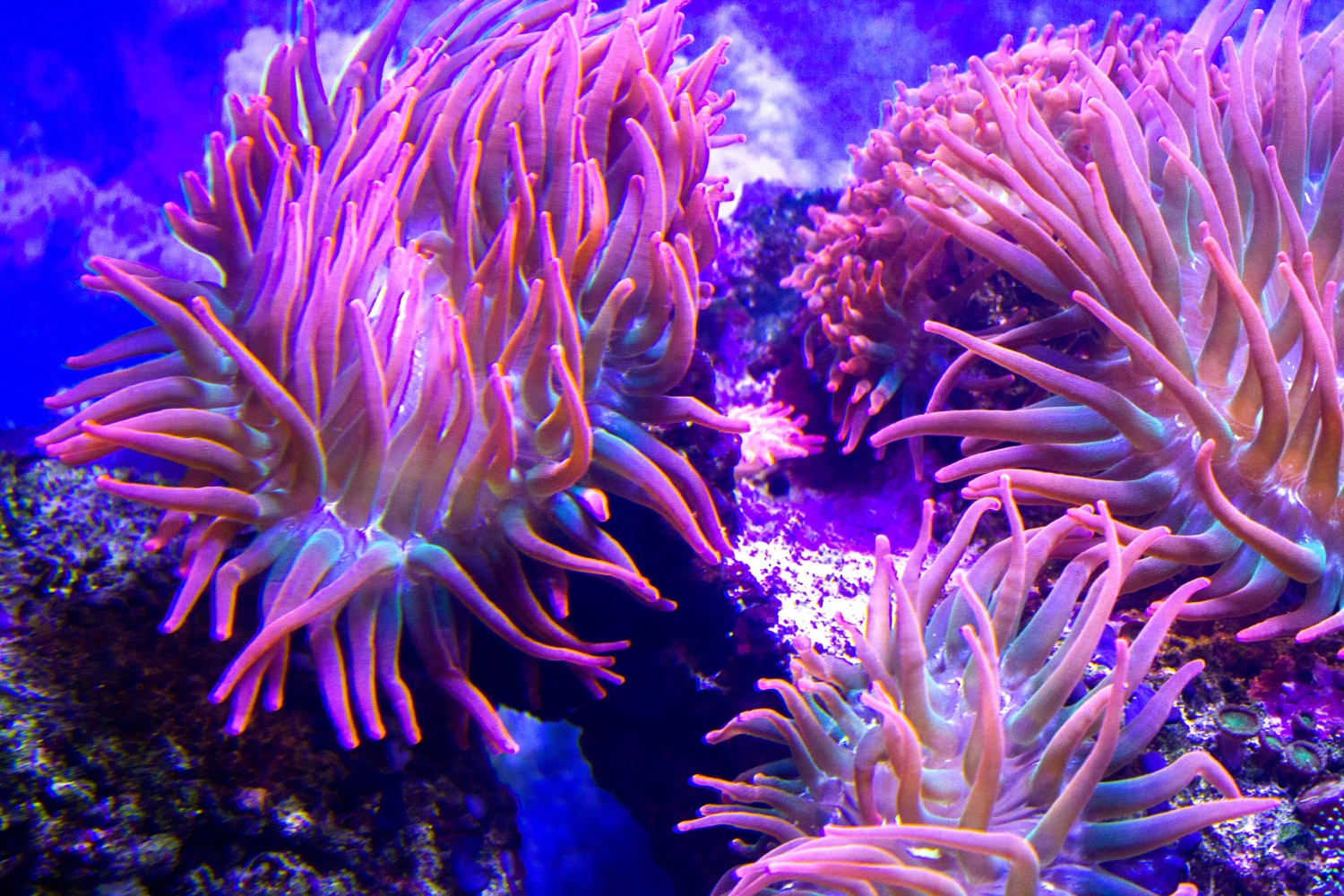
Natural history: Exaiptasia diaphana can reproduce asexually by pedal laceration, in which the animal is subdivided into generating clones that separate from small portions of the pedal disc ( Clayton, 1985). D) A founder anemone (à) surrounded by some small individuals (àà) possibly produced by clonal reproduction. C) Expanded oral disc with tentacles (some with white around base and transverse bars), mouth and dark mesenterial insertions. B) Individual showing the translucent column with scattered spots distally.

1 A) Exaiptasia diaphana on a rhodolith in Punta Ulloa. Tentacles simple, smooth, long, slender, tapering toward tips, occurring only at margin and in variable in number, same color than oral disc, some have white transverse bars around its base or on its oral face ( Fig. Oral disc brown, translucent, mouth white encircled with a brown ring, mesenterial insertions visible through oral disc as dark lines ( Fig. Column elongated, smooth, not distinctly divisible into scapus and capitulum, translucent with scattered spots distally, mesenterial insertions visible as light lines in some individuals, whitish on the distal end ( Fig. Pedal disc regularly shaped, wider than column. Synonymy: Actinia diaphana Rapp, 1829 Cribina diaphana: Deshayes & Milne-Edwards, 1840 Actinia elongata: Delle Chiaje, 1841 Adamsia diaphana: Milne-Edwards, 1857 Dysactis pallida: Agassiz in Verrill, 1864 Bartholomea tagetes: Duchassaing & Michelotti, 1864 Bartholomea inula: Duchassaing & Michelotti, 1864 Dysactis mimosa: Duchassaing & Michelotti, 1864 Dysactis minuta: Verrill, 1867 Paranthea minuta: Verrill, 1868 Paranthea pallida: Verrill, 1868 Disactis mimosa : Duchassaing, 1870 Aiptasia saxicola: Andres, 1881 Aiptasia diaphana: Andres, 1883 Aiptasia Agassizii : Andres, 1883 Aiptasia inula: Andres, 1883 Aiptasia minuta: Andres, 1883 Aiptasia mimosa: Andres, 1883 Aiptasia tagetes: Andres, 1883 Aiptasia pallida: McMurrich, 1887 Aiptasia leiodactyla: Pax, 1910 Aiptasia insignis: Carlgren, 1941 Aiptasioides pallida: Stephenson, 1918 Aiptasiomorpha diaphana: Stephenson, 1920 Aiptasiomorpha leiodactyla: Stephenson, 1920 Aiptasia pulchella: Carlgren, 1943 Aiptasia californica: Carlgren, 1952 Aiptasiomorpha minuta: Uchida & Soyama, 2001 Aipstasia pulchella : Reimer et al., 2007 Exaiptasia pallida: Grajales & Rodríguez, 2014.Ĭharacteristics of studied specimens of Exaiptasia diaphana: All taxonomic diagnostic features and measures observed in the specimens examined agree very well with those of the external anatomy described for Exaiptasia diaphana: oral disc from a few to 20 mm in diameter. This paper documents the association and constitutes the first record of this actiniarian in the Isla del Coco National Park. The sea anemone Exaiptasia diaphana ( Rapp, 1829) (= Exaiptasia pallida) was observed among the species associated to the rhodoliths. Rhodoliths are one of the groups of algae with the widest geographical, climatic and bathymetric distribution and they are considered as bioengineers due to their propensity to construct a hard and complex substrate with hollows and sinuosities, which favors the settlement of numerous species and the development of various microhabitats ( Foster, Amado-Filho, Kamenos, Riosmena-Rodríguez, & Steller, 2013 Mallol, Barberá, & Goñi, 2015). The rhodoliths constituted a benthic community dominated by free-living calcareous algae that can roll over the substrate pushed by the movement of water currents. During the expedition UCR-UNA-COCO-I to Isla del Coco National Park in April 2010, we sampled many sites including a rhodolith bed at 14 m depth, in Punta Ulloa.


In fact, only two species of sea anemones have been recorded for the island, Telmatactis panamensis ( Verrill, 1869) ( Acuña, Cortés, & Garese, 2012), and Anthopleura nigrescens ( Verrill, 1928) ( Acuña, Garese, Excoffon, & Cortés 2013). Although there have been many studies on different invertebrate groups, the sea anemones (order Actiniaria) diversity is still poorly studied. The growing interest in these investigations has been demonstrated in the recent International Symposium on Isla del Coco held in February 2018 at the University of Costa Rica. A list of published records of the marine organisms found in the area has been compiled by Cortés (2012). The marine biodiversity of Isla del Coco has been the subject of scientific interest particularly for its biogeographic relevance and diversity.


 0 kommentar(er)
0 kommentar(er)
